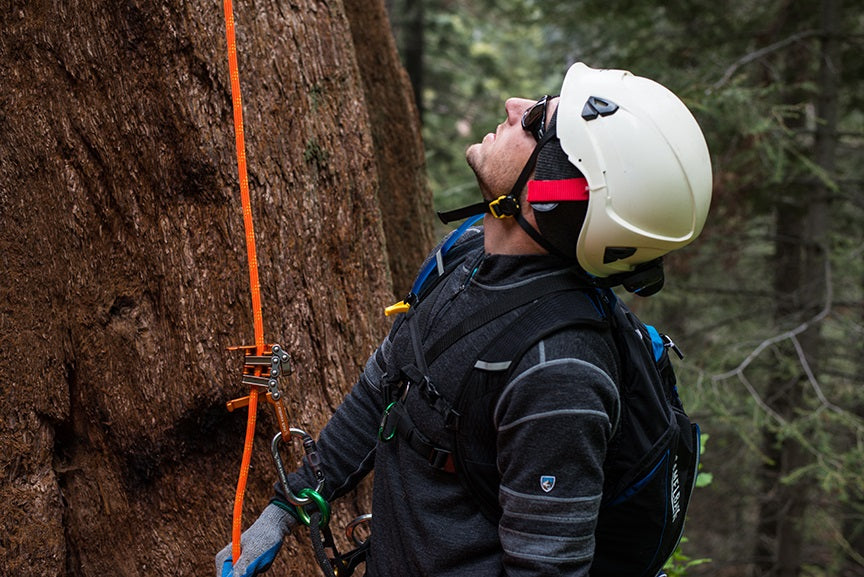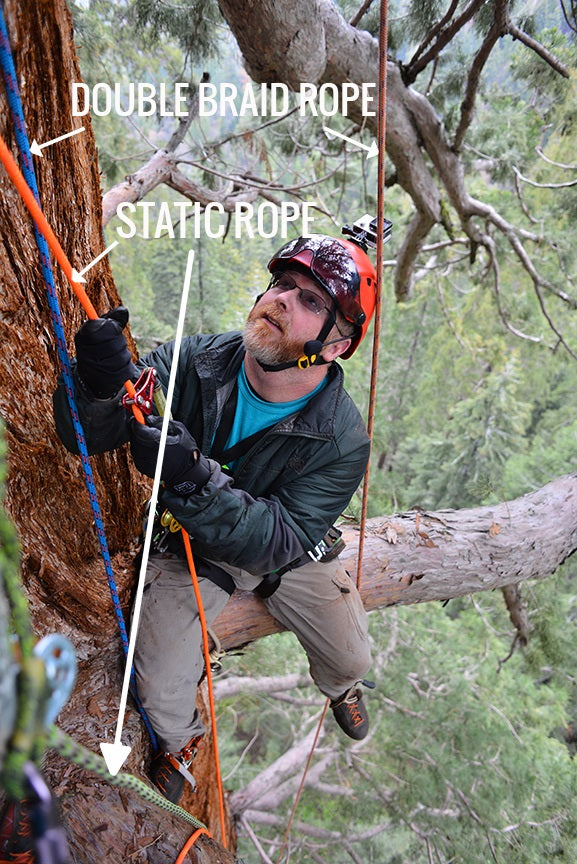
Using Different Rope for Different Kinds of Climbing
ProfDifferent Ropes for Different Folks
What is your favorite rope to climb with? Are you a True Blue fan or do you lean more towards the likes of a nice static KMIII MAX? There are tons of different climbing ropes and various climbing rope constructions that serve their own purpose in your everyday climbing. Let’s take a look at what is available and why using a different rope for different kinds of climbing is beneficial for climbers of all skill levels.

First things first: the type of climbing rope you should use depends on the type of climbing you will be doing. If you are hiking up trees with your spikes and doing heavy removals all day with a natural crotch tie-in, then you are going to be looking at a different type of rope than the climber that is always running their rope through a Pulley Saver and dead wooding big Oaks most of the time. This will also be different than the climber that is ascending and working the entire tree on an SRT system with a Rope Wrench or a Rope Runner. All of these different ropes are designed with a climbing style and purpose in mind.
A “True Blue” Climbing Rope
Solid braid construction of ropes is exactly what it sounds like. Typically, 12 strands of rope fibers are woven together to create a supple and relatively flexible rope that is capable of withstanding a good deal of natural crotch climbing. Natural crotch climbing is when you throw your rope over a limb to tie-in. Natural crotch climbing creates quite a bit of friction at your tie-in point, which in turn creates a considerable amount of heat. Heat can glaze your rope when burning out of a tree all the way to the ground, as well as damage the bark of the tree. One solid braid rope that has been around for a long time and is well known and trusted by climbers is the Samson True Blue.
True Blue is a rope that many older climbers always mention when talking about ropes. It has an all-polyester construction that is slightly stretchy but also pliable in the hand and capable of holding knots well. This rope has been used in trees by climbers for years and is still around because it is a great all around no frills rope for climbers that want to get the job done!
One downfall to solid braid construction ropes is the fact that they cannot be spliced. Due to the construction of the rope, a conventional eye splice is far too difficult and time consuming. An eye can be sewn into the end of the rope; however, sewn eyes tend to be much more bulky and can easily get stuck in a tight crotch or friction saver.
A Versatile Option
The next rope that we will discuss is a 16 strand rope. 16 strand ropes have been around for a long time as well and offer a super-tough option for climbers. 16 strand ropes are constructed differently than solid braid ropes. Where solid braid ropes are just 12 strands weaved together, 16 strand ropes feature a 16 strand polyester cover and a core made of nylon. The cover of the rope gives the rope its strength and the core helps the rope keep its shape. This type of construction makes inspecting your rope for damage very easy because any nicks or abrasions can easily be seen on the cover.
16 strand ropes work very well with a natural crotch tie-in, as well as with a friction saver or similar device. These ropes can also be hand spliced with a large eye or tight eye. Large eyes work well for climbers using a snap as their connection point. The large eye can be girth hitched to the snap for quick on and off. The tight eye is great for connecting to carabiners because the carabiner sits snugly within the eye and prevents it from cross loading. Splices also help retain the strength of the rope better than a knot – like a double fisherman or an anchor hitch – because they don’t cause any tight bends of the rope.
16 strand ropes are slightly more stretchy than solid braid construction ropes, but not to the point of notice. Having some stretch in your rope is great in the event of slipping off a limb or taking a fall into a rope. The less stretch a rope has, the more your body will feel the effects of that short fall. If the rope can’t absorb the energy created with its stretch, then your back or organs will be absorbing the energy. This could result in a trip to the chiropractor or, worse yet, the ER!
Rope Inside a Rope
Double braid ropes are another type of rope that is available to climbers. Double braid ropes usually have a 24 strand cover, as well as a braided core. Think of these ropes as a rope inside a rope because the cover and the core share the load. This typically makes double braid ropes stronger than ropes of other constructions. The 24 strand cover is incredibly smooth while being used with ascenders or with a friction saver, and though this rope can be used natural crotch, it really shines when used with something like a Pulley Saver or any type of friction saver.
Double braid ropes are easily spliced and usually come with a tight eye for use with a carabiner for the terminating end of your climbing system. The cover of a double braid rope can be inspected for damage or abrasion, but the core can’t be as easily inspected. By running the rope through your hand, you can feel for diameter changes or lumps in the core. This is a good indicator that there is a problem with the rope.
Double braid ropes usually have less stretch than any of the previously discussed ropes. This makes them great for ascending and for SRT climbing with a Rope Wrench or a Rope Runner. The tight weave of the cover keeps ascenders from snagging and allow mechanical devices to run smoothly along the length of the rope. One thing to keep in mind is the fact that the cover of the rope will tend to stretch or “milk” once the rope is used. Just run your prussic or friction hitch the full length of the rope and “milk” the cover off the core. Now tape the cover and cut it where it meets back up with the core. This is nothing to worry about if your rope “milks”!

Great for Ascending
Lastly, let’s discuss static ropes. Static ropes have very low stretch and are great for ascending because none of your energy is wasted due to the rope stretching while you are trying to step up the rope. Static ropes usually have a 32 or 48 strand cover that is very smooth and tight knit for the teeth of your ascenders to bite into. The core is usually a parallel strand construction and these ropes cannot be hand spliced.
Static ropes are more of a specialty use rope and are only used for SRT climbing or ascending. Since these ropes have such low stretch characteristics, they shouldn’t be used for doubled rope climbing. Static ropes also tend to be slightly smaller diameter than the other ropes discussed.
Hopefully, this gives you a bit of an understanding about rope construction and their intended uses. If you have any questions about ropes, please comment below or call us at (989) 635-8900 and we will be sure to help you with what you need!

Leave a comment